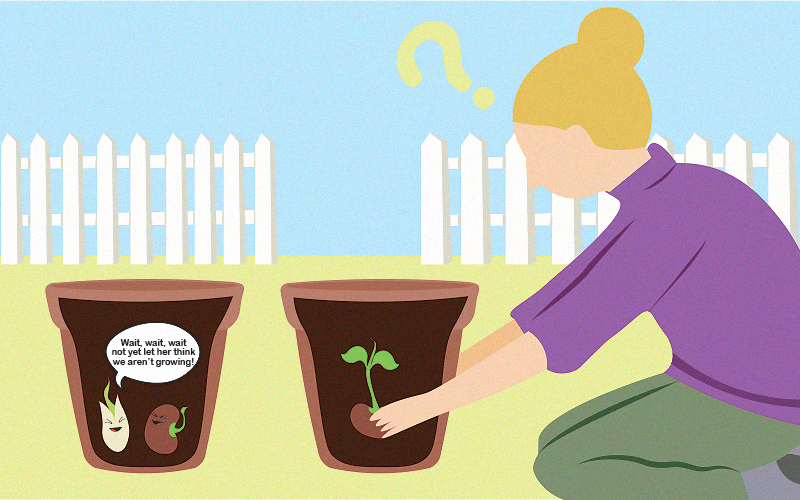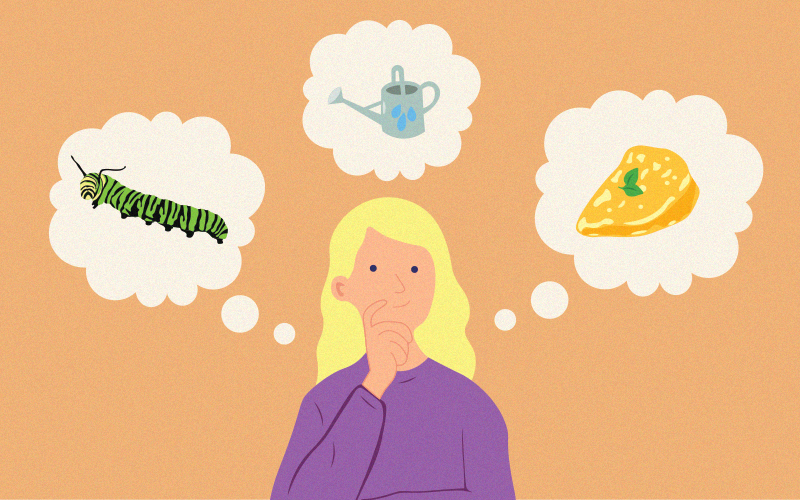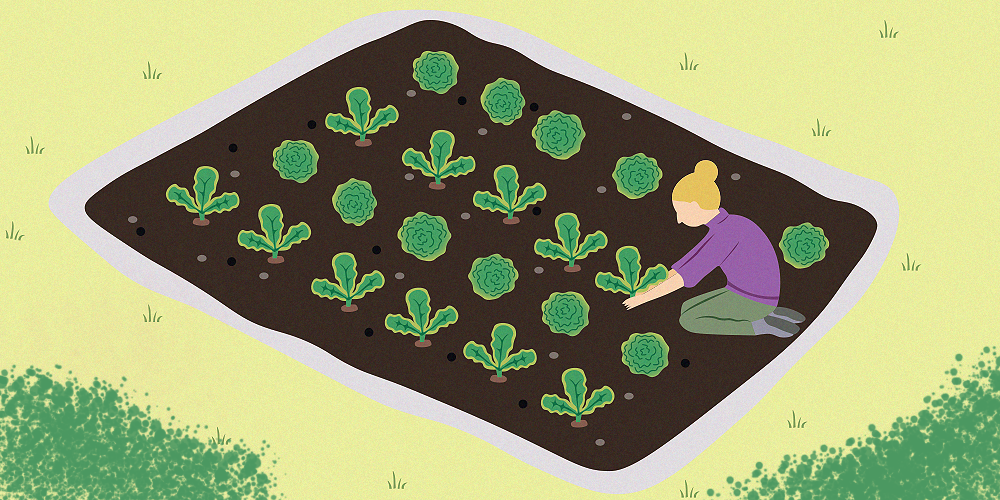I was a seasoned plant-murderer when I decided to grow my first garden last year, on the terrace of our flat. My husband threw me an incredulous look when I told him of the idea, as, admittedly, I was able to kill a cactus.
My relationship with plants was really that bad. Every potted green thing that I touched withered and died. Except for one brave cactus that survived due to the mercy of my husband, and a few dusty orchids that managed to flower every year, somehow. Despite that unfavorable forecast, setting up a little garden of my own felt like the right thing to do. The time felt right. Spring was steadily gaining ground, but instead of hope, there was fear in the air. The world was about to hole up for its first lockdown. Food shortages seemed imminent, and thoughts of a zombie apocalypse were never far behind. A little creature in my limbic system was coiled in panic, grasping for any pebble of safety to crawl under. I needed that garden. If not for the actual food it could produce, then for my own sanity.
In the next few days, we procured large fabric pots, sacks of soil from a garden center, and a cornucopia of seeds. In theory, from then on, it was a straightforward process — fill the pots with soil and press seeds into them. In practice, I had to go over instructions typed on every packet a few times before I got the courage to actually take those seeds out and do something with them. I was ashamed to admit that until that moment, I hadn’t planted anything in my life.

The irony was my ancestors grew food for ages. First as peasants in times of the Russian and Austro-Hungarian Empires, then in times of the USSR, as sovkhoz members, and then, after its fall, as small farmers. There had never been anything more natural than seeing my parents and grandparents at work on their plots of land. Sowing, planting, weeding, pruning, gathering, preserving — it was a cycle that repeated every year without fail. I witnessed it, but I had never followed the process of growing a plant from beginning to end, never nurtured a seedling, never waited for a seed to germinate, always remaining just that — a witness.
Potato planting would always stay in my memory. The process went like this: one dug out a hole in the ground with a spade, dropped a potato into it, and covered it with the earth dug out from the next hole; next potato dropped, next hole dug out, and so on, row after row until there were no more potatoes left. My whole family planted potatoes like that, among other families in our village, every year. My participation was scant. I deposited a few spuds into their allotted holes, got bored quickly, and ran on, forgetting all about them. Until, a few months later, I saw already mature plants. That was when my family called me for help again, that time picking Colorado beetles; which ravaged our crops regularly in the growing period, but in the pest department, I was hopeless too. I touched potato beetles for a penny each only — they were too revolting otherwise, and still, they did put me off taters for years to come.
My knowledge of soil and its mysteries never went deeper than that. I never wondered what happened to those potatoes after they were buried in their little graves. For all I knew, it was a miracle of resurrection when something grew out of them.
My parents didn’t press me into garden work either, as I was supposed to be “the first generation that didn’t have to grow food to survive.” For me, there was a city school and somewhere in the future, a city job, and eventually, a city flat. So, I was habitually waived off to study. I was to read my summer reading and reap the fruit of someone else’s labor. I didn’t object; no sane child of our village would when there was a way out of weeding and pest control. Those days you could see me lounging on sun-dappled grass under cherry trees, watching ants crawl over crumbly earth, stuffing myself with raspberries straight from a bush, picking a honey-sweet apricot that had just fallen from a tree, and eating it without washing the dust off — because it “was only touching the ground for a few minutes.” As my father would say, and it was “all-natural” anyway. Maybe it was that blissful memory of my parents’ garden that prompted me to set up my own tiny farm on a terrace of a London flat.
I stooped over my pots filled with earth, all ready for sowing. The soil was moist, with bits of wood, grass, and plastic in it. There was no hint of a future bounty there. That black substance looked cold, dirty, repulsive even. I didn’t want to touch it too much, so I fetched a roll of kitchen towels to wipe my fingertips on. It felt impossible that something might grow out of that. Still, like generations of farmers before me, I pressed seeds into the damp earth and waited for a miracle to happen. Potatoes had made it to the other side before, maybe my seeds would do it too.
After sowing, I inspected my demesne every day, looking out for the tiniest glimmer of green. I watered diligently but kept my ardor in check so as not to kill anything with excessive care. To my delight, in about a week I spied the first green leaves. Then after which tender stems followed, and after them, the first true leaves. I observed every stage of growth in rapture. That was something I missed out on when I was a kid. Now, I could finally witness what happened in that gap between a tuber buried and a plant in bloom.
I didn’t plant any potatoes in my garden though, thank you. My pots housed carrots, beets, and, mostly, leafy greens, something that would grow fast: spinach, chard, rocket, and kale. Soon enough, my kale attracted pretty white Lepidoptera. At first, I was excited to point them out to my husband, “Look,” I would cry out “butterflies, so high up on our terrace!” In a few weeks, it dawned on me what those visits meant for my crops. My excitement dropped and I stopped keeping our cats from hunting them. It was too late though, those winged creatures had already planted their own seeds. First, my kale went down, then my rocket fell under an onslaught of caterpillars; the voracious offspring of pretty white butterflies. My gran had always cursed when she saw them flutter towards her cabbage, and now I knew why. I wasn’t ready to surrender my plants without a battle then, and so, each day, I braced myself and picked the caterpillars off my plants. No one paid me pennies that time, as they had done for the Colorado beetles, but I kept going, for the love of my little garden.
The process of growing plants truly calmed me. Instead of thinking of an apocalypse, I thought of caterpillars, watering, thinning, or sowing more seeds. I would water my plants in the evening and inhale the smell of cool water hitting the hot surface of the terrace planks. I would go out to snap me some fresh greens for an omelet in the morning, and their leaves would be still covered with dew. It became a ritual for me to stroll among the pots when I needed to empty my head. There was no place for anxiety on that balcony.

One morning I caught myself walking around the terrace, arms interlocked behind my back, scrutinizing every plant. A living image of my mother, who inspected her garden exactly like that every morning! Not only my greens worked on their roots, but it also appeared that I myself had noticed mine. When I Skyped my parents that summer, I caught myself eagerly discussing flowers, edibles, the merits of growing strawberries, different types of soil and fertilizer, the price of seeds, and the best ways to deter pests. I grumbled about heatwaves, the absence of rain, the cost of water, and for the first time, I wasn’t bored with the garden talk. Instead, I felt deeply connected with my family. As if with all that digging in the dirt I tapped into our common groundwater.
The coming of winter didn’t deter me from my “garden therapy” as I called it now. I finally dusted those orchids, bought some more houseplants, and kept them alive, even thriving. Soil didn’t repulse me anymore. I mixed it with water and eagerly kneaded it with my bare hands, like brownie dough, before sprinkling it with seeds. I appropriated a corner of our kitchen and set up a winter garden for microgreens. We found some old shelving, a couple of grow lights, seed trays, and there I was. Growing things again — for food, but mostly, I guess, for the way it made me feel when I watched seeds germinate, sprout, and evolve into mini versions of themselves. It made me feel glad.
That kitchen corner was my bulwark of green against winter bleakness and lockdowns without end, a place of safety and hope, where things continued to live in the rays of their artificial suns. I was growing plants not exactly to stave off hunger, as my ancestors did, but to survive nevertheless. While the world was in chaos, I was holding onto my mini island of bounty. There was no place for uncertainty in that world of lush leaves and black earth. Everything followed its natural cycle, from birth to death, without fail, apart from minor disruptions of too much or too little water and a few pests. That I could manage easily. •




